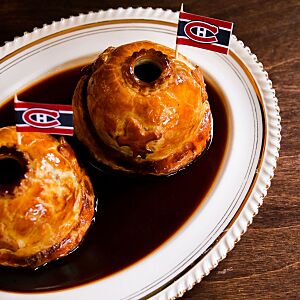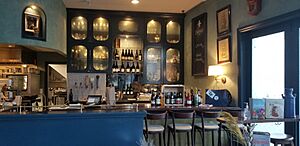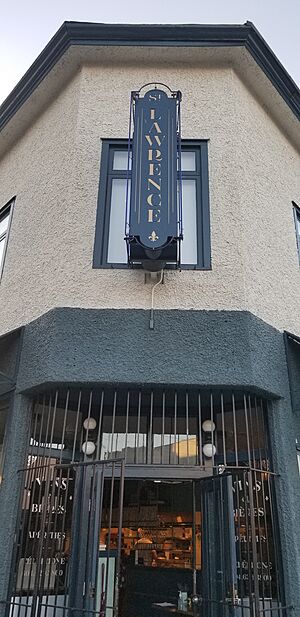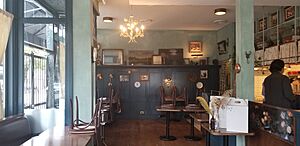St. Lawrence (restaurant) facts for kids
St. Lawrence is a special French-Canadian restaurant found in the Japantown area of Vancouver, British Columbia. It first opened its doors in June 2017. The restaurant is located on the ground floor of an old, historic building at 269 Powell Street. This building used to be a general store run by a Japanese family. St. Lawrence serves a mix of traditional Québécois dishes and fancy French cooking, known as haute cuisine. The food is usually rich and filling. The restaurant can seat 44 people, including six spots at the bar.
Contents
What Does St. Lawrence Look Like?
The restaurant was designed by a Vancouver company called Ste. Marie. The owner, Jean-Christophe Poirier, wanted the place to feel like it had always been there, not newly designed. He wanted it to feel like a cozy country home that had become a restaurant in the middle of the city.
The first idea for the restaurant's colors was cream and faded yellow. But after trying the food, the designers changed the colors to blue and green. Most of the staff speak French, coming from Quebec or France. This, along with French music playing, helps guests feel like they are visiting Quebec, even though they are in Vancouver. Many people who have reviewed the restaurant say it feels just like places in Montreal or Quebec City.
The Building's History
The building at 269 Powell Street was built in 1905. It was first home to the Komura Bros. General Store. This store was very important to the Japanese community in Vancouver. In 1942, the Komura family, like many other Japanese-Canadians, had to leave their home and store. This happened because the Canadian government moved them to special camps during World War II.
The outside of St. Lawrence still has the original tiles by the front door. You can even see the word "Komura" on them. The metal gates around the door are also original. The door and outside walls are painted a deep blue-green color. A big cream and black sign with the restaurant's name hangs above the door on the second floor.
Inside the Restaurant
Inside, the walls are green with a plaster finish, and the ceiling is light grey. The wooden parts and cabinets are painted a shiny royal blue. There's a large wooden piece on the back wall that looks like old furniture. The lights are made of brass. You'll also see fleur-de-lis symbols, which are a French emblem.
The restaurant is filled with small antique items and little decorations. Many of these are from the owner's own collection. Others were found in local antique shops. Pictures from his childhood in Saint-Jérôme, Quebec, and old oil paintings of nature are on the walls. It feels like an old country kitchen filled with treasures collected over time.
What Kind of Food Does St. Lawrence Serve?
The menu at St. Lawrence focuses on hearty, protein-rich food. The owner calls it cuisine de campagne, which means "countryside cooking." The portions are big, and the flavors are rich. This is different from what many people expect from Vancouver food, which is often seen as light and healthy.
The menu does not have poutine, which is a very famous Quebec dish. Instead, they serve pommes duchesse with cheese curds and gravy. This shows other great Quebec dishes. You might also find less common meats like sweetbreads (a type of gland), calf and chicken livers, and tongue. These appear on the regular menu and as special dishes.
Starting Your Meal
Every meal begins with a small free appetizer called an amuse-bouche. This is usually cretons, which is a spiced pork spread. It comes with sourdough bread and homemade grainy mustard.
Some dishes that are always on the menu include venison tourtière (a meat pie), mushroom vol-au-vent (a puff pastry case), and a daily pâté en croûte (a meat paste baked in pastry). Special dishes are often more detailed. For example, they might have lobster Newberg, cailles en sarcophage ("quails in a sarcophagus"), or a ling cod fish fillet for two people. Many of these dishes are old classics that are hard to find in modern restaurants.
Sauces and Desserts
St. Lawrence uses many different sauces. Some are creamy and butter-based, while others are lighter gravies like au jus. They might have up to ten different sauces cooking each night. For example, the grilled pork chop comes with sauce charcutière ("butcher's sauce"). The ling cod is served with a saffron sauce.
Just like the main courses, the desserts are old-fashioned and served in large portions. The most popular desserts are a classic sugar pie with a lattice top. There is also a rice pudding with salted caramel. This pudding comes with small pastries called pets de sœurs, which means "nun's farts."
Drinks
The bar serves only French wines. They also have a short list of classic cognac-based cocktails. You can find various beers and ciders, including Labatt 50. This beer is a popular choice for working-class people in Quebec. A small selection of Japanese whisky is also available. This is a special touch because the restaurant is in historic Japantown.

The way the food is presented at St. Lawrence is simple and honest. The owner told the Vancouver Sun newspaper that "smart presentation doesn't matter to me—food must be delicious." The presentation of many dishes includes fun touches inspired by Quebec culture. The tourtière, for example, is served with a tiny flag of the Montreal Canadiens hockey team. This team is a big cultural icon in Quebec. It also comes with a tiny bottle of Heinz Tomato Ketchup. The oreilles de crisse (deep-fried pork rinds) are served in a maple syrup can. This can is often seen as a symbol of Canada.
Special Menus and Events
In January 2020, St. Lawrence held special "cabane a sucre" dinners. The menu for these dinners was like the traditional food served at Quebec sugar shacks during the maple syrup harvest season. For these dinners, the restaurant was set up with long tables for family-style eating. They used checkered tablecloths to look like real sugar shack diners.
In April 2020, restaurants in British Columbia had to close for dining in because of the coronavirus pandemic. St. Lawrence then started a take-out service called St. Lawrence á La Maison. A part of the money from these take-out orders was given to charity.




